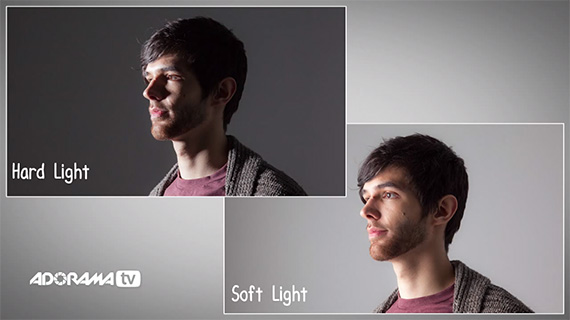If you want to be a studio photographer, there’s something you should know about: how the size of your softbox is affects the quality of light produced by it. In this video, photographer Gavin Hoey speaks specifically about soft light and demonstrates how the size of the softbox affects it:
What is Soft Light?
Soft light is about shadows and how quickly they grade from shadow to highlight. The softer the light, the smoother the gradation. On the other end of that spectrum is hard light where the gradation is not only abrupt but also pronounced. Soft light is traditionally the choice of photographers when it comes to portrait photography.

Soft light vs. Hard Light
To create soft light you have to modify your flash, and that’s where light modifiers like softboxes come into the picture. The larger the size of the softbox, the softer the quality of the light. This is exactly what Hoey is going to demonstrate next using four different sizes of light modifiers.
For all these experiments Hoey uses the same basic light: a Flashpoint RoveLight 600 Ws Monolight. Everything else in the frame—the same subject to light distance and same depth of field—are the same.
Standard Reflector
This is the smallest modifier of the lot and it’s definitely the odd one out in this experiment. Why? Because contrary to what he needs, this standard reflector actually produces hard light.

Reflector
The picture above demonstrates qualities that are identified with hard light: strong, pronounced shadows with little gradation.
28-inch Softbox
The word bigger is relative to the size of the standard reflector that Hoey used in the first shot. The one he uses in this shot is the Glow Parapop 28” R series. It has a diffusing material at the front, as well. A larger light source should result in a softer light. So, now’s the time to put that theory to test.

Glow Parapop 28” R Series
As you can see from the image below the light quality is definitely softer than before. The shadows are graded and the overall result is a lot more flattering.

Shot with the Glow Parapop 28” R Series
Umbrella with Diffuser
Although the results with the Parapop 28” R is good, it’s still not absolutely great. So this time Hoey goes for a bigger softbox. He goes for the Westcott 4631D Umbrella with a diffuser.

The Westcott 4631D Umbrella
As you can this one’s definitely up a size from the Parapop 28” R. Let’ see the result with this one.

Westcott 4631D Umbrella
And yes. The light is definitely softer.
7-foot Parabolic Umbrella
Finally, Hoey brings out the Westcott 7’ Silver Parabolic Umbrella. This is a humongous softbox and should give extremely soft light, especially with the diffusing cover on.

Westcott Parabolic Umbrella
And it does:

Westcott Parabolic Umbrella
There might be some lingering doubts in your mind whether the use of such a behemoth is actually necessary. There are some other practical uses of such a giant softbox. Especially when you need to make full length shots. A giant softbox can produce a large amount of soft light—enough to illuminate a full-length shot from a distance. This is something impossible with a smaller lightbox.
As demonstrated, choosing an appropriately sized softbox for the shots you intend to make is quite important!
Like This Article?
Don't Miss The Next One!
Join over 100,000 photographers of all experience levels who receive our free photography tips and articles to stay current:






This article does not discuss the difference the distance from the subject makes to the softness of the light. This is an important consideration as a smaller softbox nearer to the subject will give the same quality of light as a bigger one further away.